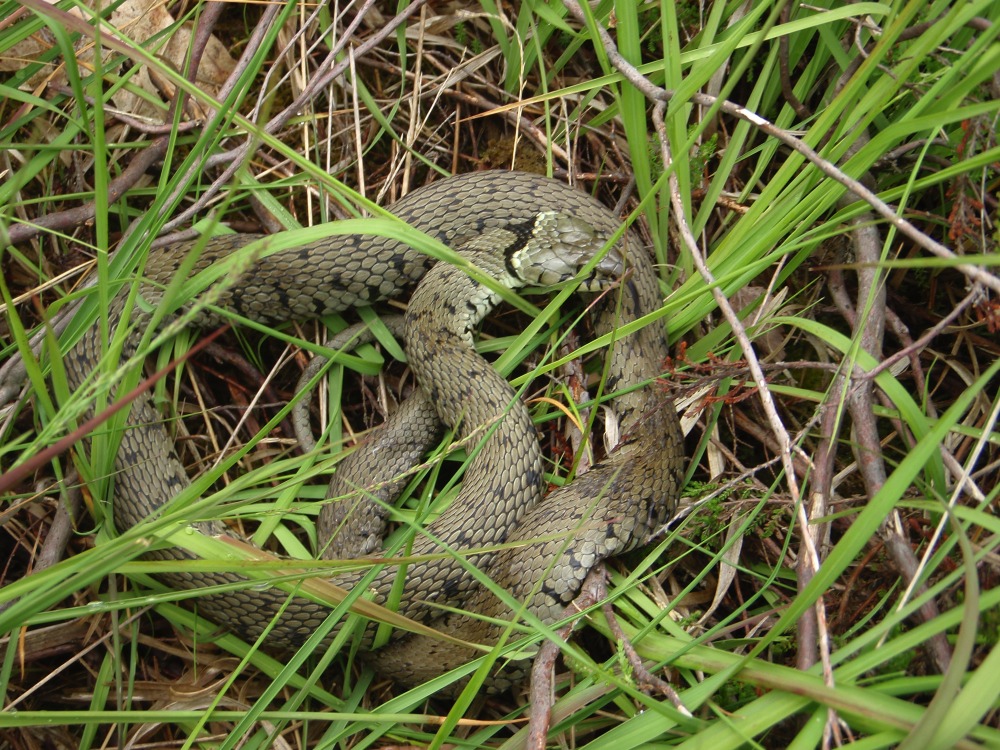Joanna Lawrence, the Fleet Pond Ranger, writes:
As we slowly move towards spring, our winter conservation work at Fleet Pond is drawing to an end. Much has been achieved over the last few months to improve and restore many of the wonderful habitats we are lucky enough to have on our doorstep!
Restoration work has continued on the dry heath to improve this rare and valuable habitat. Fleet Pond Society volunteers, volunteer groups from the Environment Agency and Nokia, and Hart Countryside’s Ranger team have all contributed to the clearance of birch scrub on the heath, which in some areas was starting to take over!
Picture: Volunteers From Nokia Working On The Dry Heath
Although some islands of scrub have been left for birds and other wildlife to use, the removal of scrub is important to let the heathland plants like heather become well established. Stumps are treated with a herbicide to stop the birch growing back, reducing the need to do this work every year! Some species such as willow and aspen are left as these trees are valuable habitats in themselves for many invertebrates.
If left to its own devises, heathland would readily turn back into woodland by a process known as succession. Fleet Pond was once surrounded by this type of heathland but the woodland has encroached on most of it. It is therefore very important to conserve and restore what we have of this rare and threatened habitat.
Restoration of the East Marsh was mentioned a few months back in another blog post. The scrub in this section was cleared and scraped back in September to make way for important wetland plant species. The good news is that this area is already showing signs of new shots of reed and other species growing through.
Picture: Cleared Reedbed In The Snow
Another threatened habitat we have at Fleet Pond is reedbeds. This winter we have cleared an area of reedbed on the western side of the Pond. The reasons for doing this form of management are as follows; to keep scrub under control and reduce succession, to maintain structural diversity, and to maintain the vigour of the reeds which is beneficial to species such as reed warblers. The vegetation that is cut is piled at the edges of the reedbed to be used by invertebrates, nesting wrens, and maybe the odd small mammal.
Picture: A Large Grass Snake
Grass snakes are commonly found in the wet reedbeds around the Pond and these piles also make great hibernacula for them to lay their eggs in. As the vegetation decays, it produces heat, (as any of you who have compost heaps will know!) which the snakes take advantage of to incubate their eggs.
Over several years, most of the reedbed around Fleet Pond will be cut in small patches like this. This form of long cutting rotations is the best method for maintaining reedbeds while also optimising their wildlife potential by reducing disturbance. Reedbeds that are harvested for thatch need to be cut every year and therefore have less wildlife value.
As ever, the Countryside Service has been supported this winter by Fleet Pond Society who have also carried out important work over the winter season. May I take this opportunity to thank all of those volunteers who have given up their Sunday mornings to help out in all sorts of weather!




Could you tell me what the large yellow flowers are that are coming out on one of the ponds. Don’t look quite like flags or lilies…quite short stemmed. Thanks for any assistance
Many thanks for the query. Can you let us know what part of the pond you are referring to as that will help us with the identification?
I have asked around and Colin Gray writes:
Yellow flowers tend to dominate spring so these could be one of a large number depending on where they are growing and what they look like, how big and so on. It’s a bit early for water lilies but it could be the wild yellow lily. If they are in the Brookly Wood enclosure they could be the dreaded Skunk Cabbage but again rather early. On the banks Kingcup (or Marsh Marigold) is a possibility. All these are very different from each other in size and
shape!
Link for picture of wild yellow lily: http://www.british-wild-flowers.co.uk/W-Flowers/Water-lily,%20Yellow.htm
Motivated by your query, Michelle Salter has written a post on Skunk Cabbages (posted April 7, 2010). Are these the ones you saw?
Hi David. Sorry it took me a while to reply but your emails had gone into my spam. They could well have been the Skunk Cabbage but not one of the flowers were open, just large yellow buds. Not sure if I can explain exactly where they were but will try. We entered Fleet Ponds via the carpark and turned left following the paths in clockwise direction. The plants were over the opposite side of the pond with houses on our left hand side and were in what appeared to be a small pond or area of water on our right hand side. Does that help at all? Thanks for your help in identification.